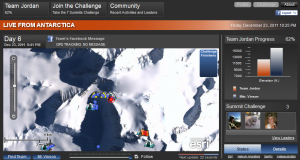My recent Antarctica Flex/ActionScript app had a requirement for tokenized asynchronous requests. That way I could use a centralized HTTP controller through which every outbound request was submitted. By attaching a “token” to each request, I could properly manage the response payload for the dozen’ish different processes that were going on. In other words, you attach a unique identifier to the outbound request. When the server sends back its response to the client application, this unique identifier is passed along in the payload. Quite cool, right?!
I’ve used this technique in heavy-duty, server-side applications before but only a few times in a web client. In practice it works brilliantly and it allowed me to easily organize the HTTP responses from many different types of requests and keep them all straight. At the heart of controller was this pseudo-code. If you haven’t done this before, there are just a few tricks to make it work right. I’ve included all the code to make your life easier. The token variable is a String that you create and then pass to the AsynchResponder.
_http = new HTTPService(); _http.concurrency = "multiple"; _http.requestTimeout = 20; _http.method = "POST"; var asyncToken:AsyncToken = _http.send( paramsObject ); //you pass the token variable in as a String var token:String = "someValue"; var responder:AsyncResponder = new AsyncResponder(resultHandler,faultHandler,token); asyncToken.addResponder(responder);
Elsewhere in the app, the other classes that used the controller received the response payload via the event bus and then filtered the response by the tokens using a switch/case statement. AppEvent is my custom event bus that would broadcast the payload to the entire application via an Event. This allowed me to fully decouple the http controller from being directly wired into my other classes. It made the app very flexible in that action would only be taken when the response came back. If you want a few more details about this architecture, then check out my blog post on it. Here’s the HTTP response handler pseudo-code that is inside the controller.
Just a note, the HTTPData Class is a custom object I wrote to manage the response data. You could manage the data anyway you like. This is just one example of how to do it.
private function resultHandler(result:Object, token:Object = null):void
{
var httpData:HTTPData = new HTTPData();
httpData.result = result.result;
httpData.token = token;
AppEvent.dispatch(AppEvent.HTTP_RESULT,httpData);
}
And, here’s the response handler that’s inside one of the applications pages (views) that recieve the payload via my event bus:
AppEvent.addListener(AppEvent.HTTP_RESULT,httpResultHandler);
/**
* Handles setting up many of the user variables based on tokenized,
* asynchronous HTTP requests.
* @param event AppEvent from HTTP request.
*/
private function httpResultHandler(event:AppEvent):void
{
var json:String = event.data.result as String;
//route the tokens through a switch/case statement
switch(event.data.token)
{
case "getallgpspoints":
parseGPSPoints2(json);
break;
}
}
You can download the entire controller example here. If you use it for your own work, you’ll have to comment out anything you don’t need like some of the import statements and the custom events. Have fun!
